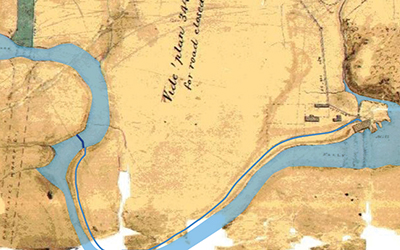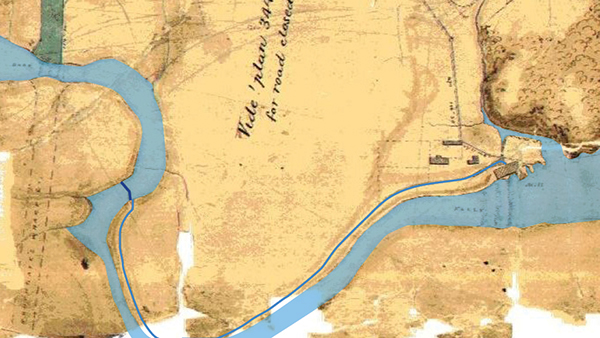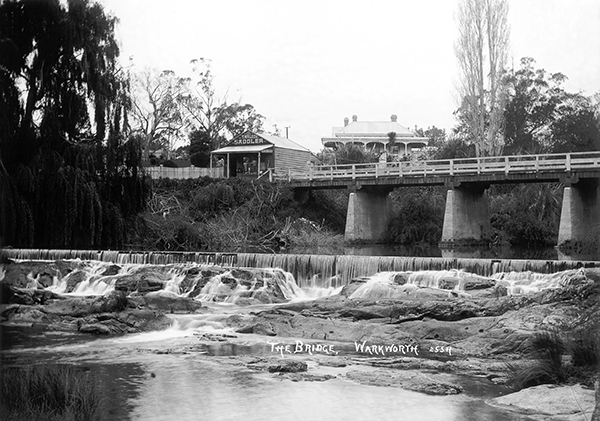Warkworth watermills millraces and weirs


Rich Portrayal of Pre-Fossil Fuel Energy: The lengths—literally half a kilometre—that John Anderson Brown had to go to harness an average of maybe 20 kilowatts from the Mahurangi River is a sobering reminder of the enormity of the challenge of replacing fossil fuels. image Auckland Council | Mahurangi Magazine
A more apposite topic for the next town-hall talk could scarcely be conceived. The fact that such a topic has already been conceived, is another story, hopefully for the following Warkworth Town Hall Talk.
On Wednesday 13 March, the historian who gave the first town-hall talk, Auckland Council principal cultural heritage specialist Robert Brassey, is back to talk on the topic that had a record 130 people attend Wednesday’s: Warkworth’s watermills, millraces and weirs.
Brassey’s first talk was not about a tidehead town and its watermills, but about a settlement downstream at Gordon Browne Bay, which had the distinction of being the first European settlement in the Auckland region. Because it didn’t survive as a town, means few Aucklanders are aware of that eight years before William Hobson chose Tāmaki Makaurau as New Zealand’s capital, Mahurangi had already been settled for four years, and abandoned for four. It was to be a further four years after Auckland’s founding—1844—before John Anderson Brown founded his Warkworth.
With the Wilson Weir in the spotlight after Warkworth awoke to the rude realisation that plans were well advanced for its removal, interest in the history of the weirs and damsthe distinction between a dam and a weir is that typically the latter is designed to be overtopped along the entirety of its width whereas a dam is built with a spillway. Whitebait buggering V-notch gauging weirs, such as that just removed adjacent the Mahurangi College are a notable exception. at the Mahurangi tidehead could not more acute. Thanks to the work done by Robert Brassey and Megan Walker on the Historic Heritage Topic Report—part of the Warkworth structure-plan process—considerably more is known about the weirs and dams, their attendant millraces, and the town’s two watermills. The Wilson Weir, of course, was not built to power a watermill, but to supply the Wilson Cement Works with freshwater. But because the dam and weir built to power the town’s first industry, sawmilling, were wooden, none of their fabric survives, in contrast to the Portland-cementI stand to be corrected, in that while Wilsons were the first to manufacture Portland cement in Aotearoa, and were sending it to Auckland by the shipload , they were slow to use the new-fangled product on site, the builders preferring what they knew, being lime cement concrete of the town’s suddenly stoutly defended Wilson Weir.

Iconic Weir Could Give Īnanga Leg-Up: There is no going back. In an ideal, whitebait-aware world it would not have taken the promise to rip out the Wilson Weir to sting Warkworthians into action to belatedly address the barrier to īnanga passage that the structure presents. But while work is feverishly underway on alternatives to losing the Wilson Weir, what better topic for the 13 March town-hall talk than Warkworth Watermills, Millraces and Weirs! image Tudor Washington Collins
Had the weir been removed immediately after the Wilson Cement Works finally ceased production in 1919—after a brief reprieve provided by production at Portland being interrupted by a water shortage there—there would be scant possibility of consent being forthcoming to allow one to be built today. But this will likely change as the enormity of global warming bites, and the realisation that run-of-river hydroelectric power generation will be increasingly be needed. Few appreciate the scale of the challenge of adapting to fossil-fuel-free energy supply. A practical and highly visible demonstration of the degree of difficulty could be provided by installing a generator sized to harness the head provided by the heritage Wilson Weir, and the flow routinely available. While this had probably been previously contemplated earlier, Energy and the Dammed Mahurangi explored the possibility in 2010. But within the last two years a locally-based consultancy had begun work on a Wilson Weir-based generating scheme specifically designed to improve whitebait passage. Counterintuitively, not only is it practicable for a generator installation to be arranged so that it provides improved access for whitebait, it provides, as Matthew Bloxham explained during this month’s town-hall talk, one of the few ways whitebait can attain legal protection.
Whitebait, at the Mahurangi tidehead, have always been sitting ducks to some extent. Prior to the construction of the various dams and weirs, the fresh Mahurangi discharged into the tidehead through a veritable natural v-notch gauging weir albeit not as vicious on whitebait, nor hightide-mitigated, as the one built by the regional council beside the Mahurangi College in the 1980s. Millennia before human predation, cormorants and other fish enjoyed easy pickings there—it is the natural order that the vast majority of whitebait larvae hatching will provide food for other species. Only a tiny minority ever finds its way to the fresh water whitebait species need to mature. And despite the misconception that went uncorrected by the several scientists present on Wednesday, only a tiny fraction of those whitebait that make it to fresh water do so in the river of birth. Whitebait are not Pacific salmon; they are driven to migrate to fresh water per se, not to their geographic birth river—natally philopatric they are not.
Southern Hemisphere-wide common galaxias, or īnanga, is very widespread. While in Australia the species is not considered to be at risk, in Aotearoa it is assessed as declining. While it is not in the next direr vulnerable category of the shortjaw kōkapu, nor is it where it belongs with the only endemic galaxiid not threatened, the banded kōkapu. Against the annual West Coast, New Zealand, harvest, which aquaculturist Paul Decker stated Wednesday was in the order 500 million whitebait—a hundred for every New Zealand man, woman and child—and the country’s many individually famous whitebait rivers such as the Mokau, the Mahurangi may appear astondingly unimportant. But the benefit to the human psyche of being close to the diversity of nature cannot be overstated, and a town built right where whitebait breed should readily summons the decency to ensure that those hardy few whitebait that survive the terrible odds against them to reach the Wilson Weir do not face the equivalent of a firing squad of ducks and human whitebaiters, but given a fighting chance of reaching maturity.
Arguably, Warkworth’s rich history of watermills millraces and weirs can best be preserved by also preserving the Wilson Weir, and by folding in the rich natural history of galaxiids, so beautifully named, for theyea, our Milky Way galaxy.
